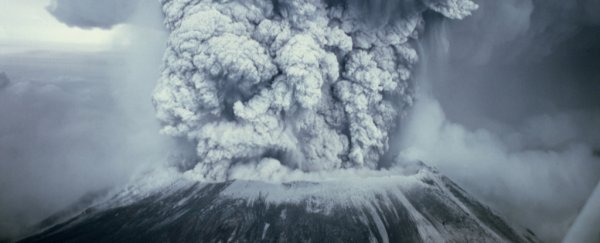The assassination of Julius Caesar in 44 BCE triggered a nearly two-decade power struggle that led to the fall of the Roman Republic and the rise of the Roman Empire.
Historic records say the period was marked with strange sightings in the sky, unusually cold weather and widespread famine - and a new study suggests a volcanic eruption in Alaska may have been the cause.
The paper was published in the Proceedings of the National Academy of Sciences on Monday.
An international team of scientists and historians used an analysis of volcanic ash (tephra) found in Arctic ice cores to link the period of unexplained extreme climate in the Mediterranean with the crater-forming eruption of Alaska's Okmok volcano in 43 BCE.
"To find evidence that a volcano on the other side of the Earth erupted and effectively contributed to the demise of the Romans and the Egyptians and the rise of the Roman Empire is fascinating," said lead author Joe McConnell of the Desert Research Institute (DRI) in Reno, Nevada.
The advent of the Roman Empire also brought an end to the dynasty of Ptolemies, the last of the pharaohs.
"It certainly shows how interconnected the world was even 2,000 years ago," added McConnell.
He and Swiss researcher Michael Sigl began investigating the matter when they found an unusually well-preserved layer of ash in an ice core sample last year.
New measurements were then made on ice cores from Greenland and Russia, some of which were drilled in the 1990s and stored in archives.
They were able to make out two distinct eruptions: a powerful but localized and short-lived event in early 45 BCE, followed by a much larger, more widespread event in 43 BCE, with fallout lasting more than two years.
Perfect match
A geochemical analysis was performed on the ash samples found in ice from the second eruption, and it perfectly matched the Okmok event - one of the largest eruptions of the past 2,500 years.
"The tephra match doesn't get any better," said volcanologist Gill Plunkett from Queen's University Belfast.
The team gathered more supporting evidence from across the world, from tree-ring based climate records in Scandinavia to cave formations in northeast China.
These data were fed into a climate model, which suggested that the two years following the eruption were some of the coldest in the Northern Hemisphere for 2,500 years.
Seasonally averaged temperatures may have been as much as seven degrees Celsius (13 degrees Fahrenheit) below normal for the summer and autumn following the eruption, with autumn precipitation reaching as high as 400 percent of normal in southern Europe.
"In the Mediterranean region, these wet and extremely cold conditions during the agriculturally important spring through autumn seasons probably reduced crop yields and compounded supply problems during the ongoing political upheavals of the period," said classical archaeologist Andrew Wilson of the University of Oxford.
They also coincided with failure of the Nile to flood the plains and the disease and famine that ensued, added Yale University historian Joe Manning.
Strange sightings
The eruption may also explain unusual atmospheric phenomena noted in the records, like solar halos, the sun darkening in the sky, or three suns appearing in the sky - a phenomenon known as a sun dog.
But the authors added that many of these observations took place prior to the Alaskan eruption and could be related to the smaller eruption of Mount Etna in 44 BCE.
McConnell said that while many factors contributed to the fall of the Roman Republic and Ptolemaic Kingdom, the eruption of Okmok played an important role, and helps fill a knowledge gap that had puzzled historians.
